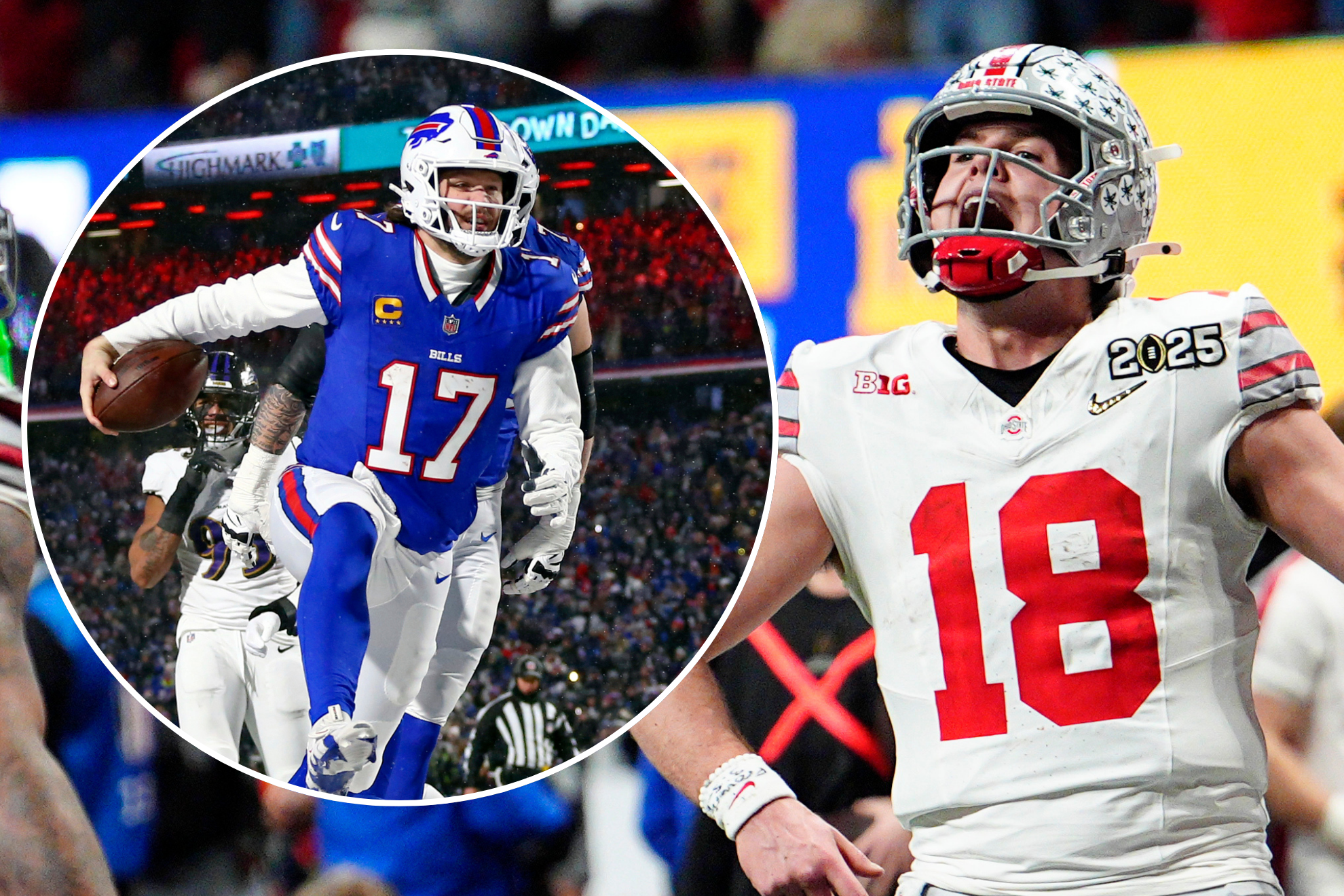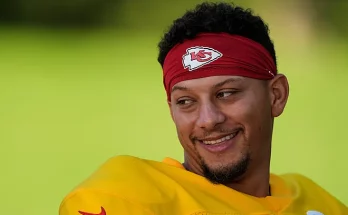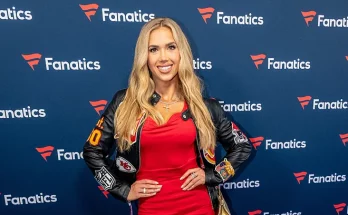In the world of football, few positions demand more scrutiny, celebration, and criticism than that of the quarterback. It’s the role with the brightest spotlight and the heaviest expectations. Every year, new college stars aim to prove they’re the next great signal-caller, and inevitably, comparisons to NFL greats begin. One such comparison gaining traction in scouting circles is between Ohio State quarterback Will Howard and the NFL’s reigning MVP, Josh Allen. While both are big-bodied, strong-armed quarterbacks with mobility, the differences in their games, developmental paths, and intangible traits underscore the complexities of projecting college talent to the pros.
On paper, the comparison may seem logical. Howard, a Kansas State transfer now leading the Buckeyes, possesses a similar build to Allen — both towering over 6-foot-4 and weighing north of 230 pounds. Both can uncork 60-yard bombs with relative ease, and both can tuck the ball and run over defenders. But beyond those surface-level similarities, the contrast between Will Howard and Josh Allen is both startling and instructive.
Will Howard: A Work in Progress with an NFL Ceiling
Will Howard’s journey to Ohio State was never the traditional five-star quarterback story. A three-star recruit out of Downingtown West High School in Pennsylvania, Howard found himself under the radar during his recruitment. Yet, he quickly made waves at Kansas State, earning playing time as a true freshman in 2020. Over four seasons with the Wildcats, Howard flashed moments of brilliance, especially during a resurgent 2022 campaign in which he helped guide K-State to a Big 12 Championship.
Howard’s decision to transfer to Ohio State in 2024 was both bold and calculated. He stepped into a program steeped in quarterback talent and national title aspirations. Ryan Day’s offense promised exposure, high-level competition, and the kind of spotlight that could vault Howard into NFL Draft contention.
Through spring practices and early reports, Howard has emerged as the frontrunner to start for the Buckeyes. Scouts love his frame and arm strength. He can make every throw on the field and is particularly adept at launching deep balls off play-action. His mobility — not just scrambling, but designed runs — is also a major asset. However, his game still contains inconsistencies. He can be streaky with his accuracy, especially on intermediate routes, and struggles with timing-based throws against complex zone defenses.
Howard also hasn’t shown the elite playmaking instinct under pressure that defines top-tier NFL quarterbacks. While he’s improved each year, scouts question whether he has the processing speed and poise to adapt quickly to the hyper-accelerated mental demands of the NFL.
Josh Allen: From Raw Prospect to MVP
To understand why Will Howard’s development arc draws so many comparisons to Josh Allen, one must revisit the Wyoming product’s unlikely ascent.
Coming out of high school in Firebaugh, California, Allen had zero FBS scholarship offers. He ended up at a junior college before transferring to Wyoming, where he dazzled scouts with an enormous arm and elite athleticism. But his college tape was a mixed bag: erratic accuracy, questionable decision-making, and limited production against elite competition. Still, the Buffalo Bills took a massive gamble on his upside, selecting him seventh overall in the 2018 NFL Draft.
Allen’s first two years in the league did little to silence critics. His completion percentage hovered in the low 50s, and he often played hero ball with reckless abandon. Then came 2020. Allen made a historic leap, refining his mechanics, building chemistry with Stefon Diggs, and mastering Brian Daboll’s offense. By 2023, he was named NFL MVP after throwing for over 4,500 yards and accounting for 45 total touchdowns.
What separates Allen isn’t just his size or arm — it’s his mental evolution. His ability to read defenses, adjust protections, and improvise under duress has become elite. He’s the rare quarterback who blends power and finesse, gunslinger aggression and surgical precision.
Comparing Tools: A Study in Nuance
From a scouting standpoint, Howard and Allen share certain measurables. Both are prototypical NFL quarterbacks in terms of size and athleticism. Both can throw off-platform, execute designed runs, and throw on the move. But Allen’s tools are simply rarer. He has a stronger arm — perhaps the strongest in the NFL — and his release is quicker. More importantly, Allen’s athleticism is generational; he hurdles defenders and breaks tackles like a tight end.
Howard is athletic, but not in the same tier. He’s a capable runner, but he doesn’t possess Allen’s burst or creativity in the open field. Where Allen is a threat to gain 40 yards on a scramble, Howard is more of a tough runner who picks up chunks but doesn’t explode through seams.
Mechanically, Allen’s early flaws were rooted in inconsistency. But he committed to intense offseason work, especially with QB coach Jordan Palmer. His improvements in footwork and release point were dramatic. Howard, by contrast, is still ironing out his mechanical issues. He often overstrides, which leads to high throws, and he doesn’t always reset his base after pressure. These are coachable traits, but they will need to be addressed before he can succeed in the NFL.
Mental Processing and Poise
This is where the gap widens. Allen’s rise was fueled by his mental development. He now processes the field at an elite level — identifying blitz packages, manipulating safeties with his eyes, and making second and third reads at high speed. His ability to escape pressure and make something out of nothing has become the stuff of legend.
Howard is still developing in this area. At Kansas State, the offense leaned heavily on quick reads and simplified progressions. At Ohio State, he’ll face far more NFL-style defenses and will be tasked with mastering a more complex system. Early reports suggest progress, but there’s no guarantee Howard will ever reach the same mental plateau as Allen.
NFL coordinators stress the importance of pre-snap recognition, audibles, and post-snap reaction speed. Allen has turned these into strengths. Howard, for now, remains more reliant on structure and less adept at diagnosing coverages in real time.
Leadership and Intangibles
Both quarterbacks are respected leaders, but they project differently in demeanor. Allen’s fiery energy, competitive edge, and emotional connection with teammates are core to his leadership style. He plays with swagger and embraces the pressure of the moment.
Howard is more understated. Coaches have praised his maturity, work ethic, and willingness to grind, but he’s not the same emotional catalyst. That’s not necessarily a negative — there’s room for all leadership styles — but Howard has yet to showcase the galvanizing presence that elite NFL QBs often exude.
Where Allen commands a room with raw charisma, Howard tends to lead by example. That works in college. In the NFL, where leadership in the locker room is paramount, it’s still unclear how Howard will assert himself.
Production vs. Projection
Perhaps the most striking contrast between the two lies in the gap between college production and NFL projection. Allen wasn’t a statistically dominant college QB — he threw for just 1,812 yards and 16 touchdowns in his final season at Wyoming. Yet scouts fell in love with the “tools.”
Howard, on the other hand, is producing respectable numbers in college and is now doing so at a premier program. But the NFL’s evaluation lens is different. Will Howard’s stats won’t be enough to vault him into the top of the draft unless his traits jump off the screen during the pre-draft process.
Allen proved that poor stats can be overcome with raw upside and relentless development. Howard will need to do the opposite: pair solid production with enough upside to convince a team that he’s worth developing. That’s a tougher sell in today’s NFL, where patience is in short supply.
Coaching, Environment, and the Right Fit
Another key variable in Allen’s success was situation. The Bills built around him: they hired the right offensive coordinator (Daboll), added elite receivers (Diggs), and crafted an offense that suited his strengths. Few quarterbacks succeed without the right ecosystem.
Howard’s NFL trajectory may hinge entirely on fit. He’s not a plug-and-play prospect for every scheme. He’ll need a creative offensive staff, a strong run game, and patience. Teams like the Pittsburgh Steelers, Minnesota Vikings, or Atlanta Falcons — franchises known for stable development structures — might be better landing spots than, say, QB-needy teams with chaotic environments.
Draft Stock: Where Does Will Howard Stand?
As of now, Will Howard is considered a Day 2 prospect by most evaluators. That could change if he dominates at Ohio State, tests well at the Combine, and interviews with poise. If he leads the Buckeyes to a College Football Playoff appearance and refines his mechanics, scouts may begin to view him as a low-first-rounder.
However, he’s unlikely to reach Allen’s pre-draft hype level — even as polarizing as Allen was, his physical ceiling was jaw-dropping. Howard’s ceiling is more modest: a potential long-term starter, not a future MVP.



